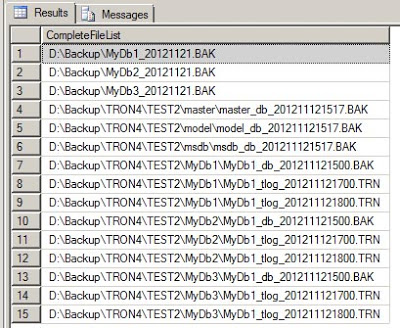In a previous blog post, I demonstrated how you can use an undocumented stored procedure, master.sys.xp_dirtree, to list all files in a folder. The previous posting mostly talked about how the stored procedure worked and the output it generated. For this posting, I have expanded upon the script to parse all subdirectories and list all files in all subfolders from the starting point.
Just for a quick review, xp_dirtree has three parameters:
- directory - This is the directory you pass when you call the stored procedure; for example 'D:\Backup'.
- depth - This tells the stored procedure how many subfolder levels to display. The default of 0 will display all subfolders.
- isfile - This will either display files as well as each folder. The default of 0 will not display any files.
Now for the updated script:
--This is your starting point. SET @BasePath = 'D:\Backup'; --Create a temp table to hold the results. IF OBJECT_ID('tempdb..#DirectoryTree')IS NOT NULL DROP TABLE#DirectoryTree; CREATE TABLE #DirectoryTree ( ,subdirectory nvarchar(512) --Create a clustered index to keep everything in order. ALTER TABLE #DirectoryTree ADD CONSTRAINT PK_DirectoryTree PRIMARYKEY CLUSTERED (id); --Populate the table using the initial base path. INSERT#DirectoryTree (subdirectory,depth,isfile) EXEC master.sys.xp_dirtree @BasePath,1,1; UPDATE#DirectoryTree SET fullpath = @BasePath; --Loop through the table as long as there are still folders to process. WHILE EXISTS (SELECT id FROM #DirectoryTree WHEREisfile = 0) --Select the first row that is a folder. ,@Path = @BasePath + '\' + subdirectory FROM #DirectoryTree WHERE isfile = 0; --Do this section if the we are still in the same folder. INSERT #DirectoryTree (subdirectory,depth,isfile) EXEC master.sys.xp_dirtree @Path,1,1; --Delete the processed folder. DELETE FROM #DirectoryTree WHEREid = @Id; --Do this section if we need to jump down into another subfolder. SET @BasePath = @FullPath; --Select the first row that is a folder. ,@Path = @BasePath + '\' + subdirectory FROM #DirectoryTree WHERE isfile = 0; INSERT #DirectoryTree (subdirectory,depth,isfile) EXEC master.sys.xp_dirtree @Path,1,1; --Delete the processed folder. DELETE FROM #DirectoryTree WHEREid = @Id; SELECT fullpath + '\' + subdirectory AS 'CompleteFileList' ORDER BY fullpath,subdirectory; IF OBJECT_ID('tempdb..#DirectoryTree')IS NOT NULL DROP TABLE#DirectoryTree; This code will process one folder level at a time since we're specifying 1 for the depth parameter. For each folder in the #DirectoryTree table, we get a list of files and subfolders and insert it to the #DirectoryTree table.
INSERT#DirectoryTree (subdirectory,depth,isfile) EXEC master.sys.xp_dirtree @Path,1,1;
If it's a folder, then it the file parameter will be 0 and the WHILE loop will process once it gets further down the loop. The folder needs a clustered index to keep all the rows in order.
ALTER TABLE #DirectoryTree ADD CONSTRAINT PK_DirectoryTree PRIMARYKEY CLUSTERED (id);
After each folder is processed, the folder row is deleted from the table. This is necessary so the WHILE loop doesn't turn into an infinite loop.
DELETE FROM #DirectoryTree WHEREid = @Id;
The full path is being saved for output later, so comparing it to the current base path will let us know if we need to update the @BasePathparameter.
--Continue processing the same folder. SET @BasePath = @FullPath; --Start processing the next subfolder.
This is how we can keep looping through each subfolder until each one has been processed.
The final step is to output the results.
SELECT fullpath + '\' + subdirectory AS 'CompleteFileList' ORDER BY fullpath,subdirectory; I have gotten pretty good performance out of this script. Even traversing the C:\Windows folder on my test VM, I can get the report to return all 62000+ files in 14000+ folders within about 6 minutes. Hopefully this example will prove to be helpful for your everyday tasks. Enjoy!



